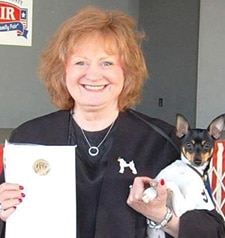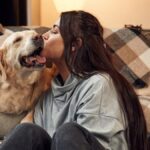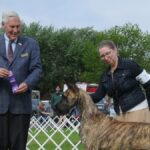The Toy Fox Terrier is an American breed that was developed by dog fanciers in the 1930s. It is said that this was achieved by crossing “runt” Fox Terriers with Toy breeds such as the Miniature Pinscher, Italian Greyhound, and Chihuahua to create a diminutive dog while retaining Terrier gameness, courage, and animation.
Relatively new to the AKC, the Toy Fox Terrier was only accepted as Foundation Stock in 2001 and became eligible to fully participate in conformation events in 2003. Since that time there has been a significant improvement in the overall quality of the TFT. Limited only by height parameters (and not restricted by weight) allowed breeders to develop a dog with both strong bone and good substance, even in those dogs at the higher end of the breed standard for height. Tall, willowy TFTs on spindly legs are seldom seen in the AKC show ring anymore.
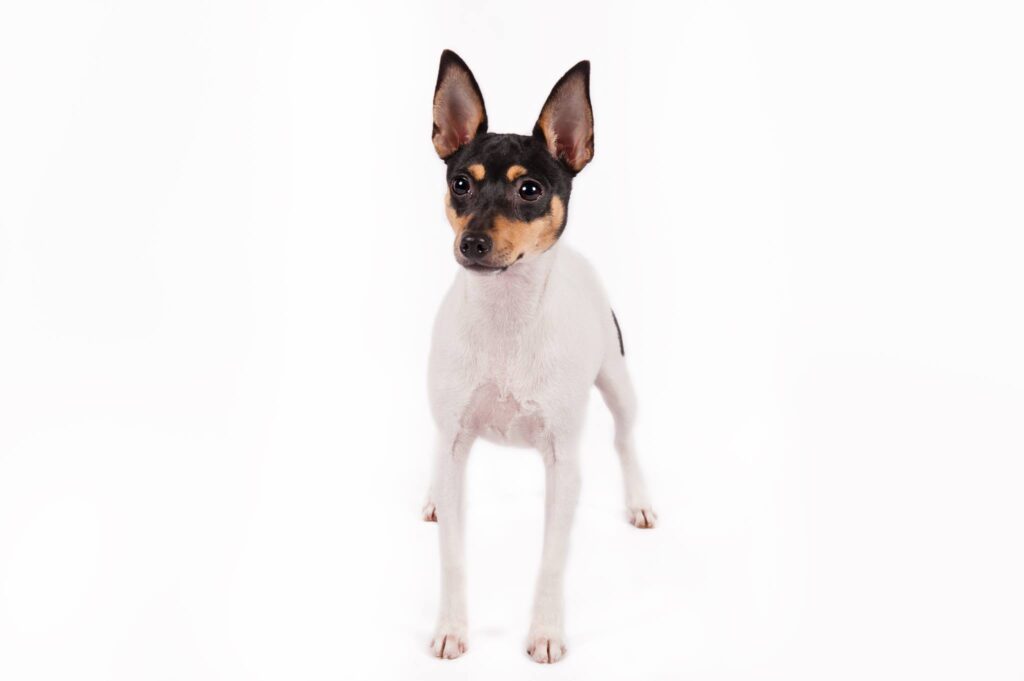 The Toy Fox Terrier displays his Terrier-like, self-possessed and spirited attitude as he enters the show ring with both his head and tail carried erect. His smooth and flowing movement, coupled with good reach and strong drive, shows no hint of a bounce or hackney gait. A properly moving Toy Fox Terrier literally owns the ground he walks on. He is a well-balanced, athletic little dog with his grace and agility equaled to his strength and stamina. He’s all about Structure and Movement!
The Toy Fox Terrier displays his Terrier-like, self-possessed and spirited attitude as he enters the show ring with both his head and tail carried erect. His smooth and flowing movement, coupled with good reach and strong drive, shows no hint of a bounce or hackney gait. A properly moving Toy Fox Terrier literally owns the ground he walks on. He is a well-balanced, athletic little dog with his grace and agility equaled to his strength and stamina. He’s all about Structure and Movement!
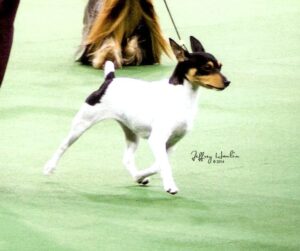 While the TFT is a natural “show-off” and enjoys strutting his stuff in the show ring, he does not necessarily like the table—and this should be understood by the judge. The first step in making this a positive experience for both the dog and the judge is to give the dogs some space. In an effort to avoid the dog being crowded and stepping back from the judge, the exhibitor can set the dog slightly further back on the table, leaving plenty of room for the judge to approach and conduct the examination. Many exhibitors train their show dogs to move into different positions by using a “crowding their space” maneuver, so it’s only natural to expect the dog to react if crowded. The next step is to keep in mind that the judge is checking for a scissors bite, which can easily be determined by examination of the front and both sides of the teeth, without even opening the mouth. There is no need to count teeth since missing teeth are not to be faulted. The TFT is examined on the table with gentle and confident hands, judged on the floor, and know that the happy little dog you see on the ground may not be so inclined to give you ears and tails up when he’s on the table.
While the TFT is a natural “show-off” and enjoys strutting his stuff in the show ring, he does not necessarily like the table—and this should be understood by the judge. The first step in making this a positive experience for both the dog and the judge is to give the dogs some space. In an effort to avoid the dog being crowded and stepping back from the judge, the exhibitor can set the dog slightly further back on the table, leaving plenty of room for the judge to approach and conduct the examination. Many exhibitors train their show dogs to move into different positions by using a “crowding their space” maneuver, so it’s only natural to expect the dog to react if crowded. The next step is to keep in mind that the judge is checking for a scissors bite, which can easily be determined by examination of the front and both sides of the teeth, without even opening the mouth. There is no need to count teeth since missing teeth are not to be faulted. The TFT is examined on the table with gentle and confident hands, judged on the floor, and know that the happy little dog you see on the ground may not be so inclined to give you ears and tails up when he’s on the table.
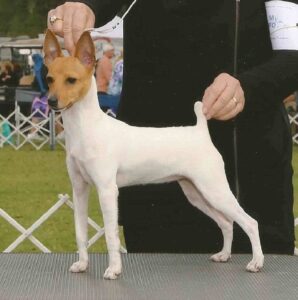 The Toy Fox Terrier is not a cookie cutter breed, and this is not a bad thing as long as each style is within the breed standard. There can be significant stylistic differences from breeder to breeder, region to region, and coast to coast. One of the many wonderful things about these delightful little terriers is that there’s something for everyone! The diverse height standard of 8 ½ to 11 ½ inches at the withers allows breeders a choice as to how they would like their breeding program to develop, regarding size. It is also important for judges to understand that neither “short” nor “tall” is either right or wrong; it’s which exhibit best exemplifies the written AKC Breed Standard in all aspects of that standard—regardless of size.
The Toy Fox Terrier is not a cookie cutter breed, and this is not a bad thing as long as each style is within the breed standard. There can be significant stylistic differences from breeder to breeder, region to region, and coast to coast. One of the many wonderful things about these delightful little terriers is that there’s something for everyone! The diverse height standard of 8 ½ to 11 ½ inches at the withers allows breeders a choice as to how they would like their breeding program to develop, regarding size. It is also important for judges to understand that neither “short” nor “tall” is either right or wrong; it’s which exhibit best exemplifies the written AKC Breed Standard in all aspects of that standard—regardless of size.
Then we come to color! There are nine disqualifications listed in the Toy Fox Terrier Breed Standard and six of them pertain to color. One might think we are just a little color-obsessed, so here are some points to keep in mind regarding color and
color combinations:
- Body spots on black-headed tri-colors must be black
- Body spots on chocolate-headed tri-colors must be chocolate
- Body spots on white and blacks must be black
- Body spots on white and tans must be tan
(Those first four points can be summed up with one simple sentence: The color of body spots must be the same color as the predominant head color!)
- A blaze must not extend into the eyes or ears
- Head must be more than 50% colored
- Body must be more than 50% white
- Nose color must be black with the exception of chocolates, which are self-colored
Toy Fox Terriers may or may not have body spots, but either white-bodied or spotted-bodied is well within the standard, and each should be given equal consideration. And, as if there has not already been enough written about color, there are a few more points that are well worth mentioning.
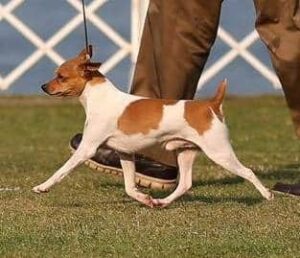
While body spots on black-headed tri-colored TFTs are black, and body spots on chocolate-headed tri-colored TFTs are chocolate, a slight tinge (or fringe) of tan alongside any body spots near the chest and under the tail is considered normal bi-color patterning and, therefore, should not be faulted.
It is also important to note that it is not a fault or a disqualification for a Toy Fox Terrier to sport grey hairs. There is a gene that occurs with some regularity in this breed, and many fine examples of TFTs tend to grey early. This should be regarded as insignificant when judging the Toy Fox Terrier. It is preferred that the portion of the coat that is white be “clear white.” However, a small amount of ticking is not to be penalized.
Hopefully, this explanation of color has cleared up any lingering questions on the subject.
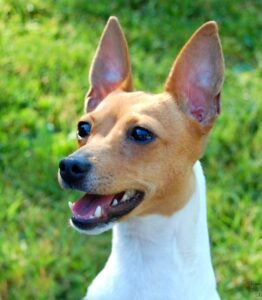
My advice to new exhibitors and new breeders would be to bring a sense of passion to your love of the Toy Fox Terrier. Never stop learning and know that this smart, comical, and entertaining little breed will, at times, keep you humble in the show ring! For as much they can be loving, loyal, and faithful companions, I would urge new breeders to also maintain their terrier gameness, along with their spirited and self-possessed attitude, and their sense of determination and courage, by keeping those traits strongly rooted in their breeding programs so as to not breed out that which embodies the total Toy Fox Terrier.
References
The Toy Fox Terrier Official Breed Standard, The Toy Fox Terrier Illustrated Breed Standard, The Toy Fox Terrier Judges Guide


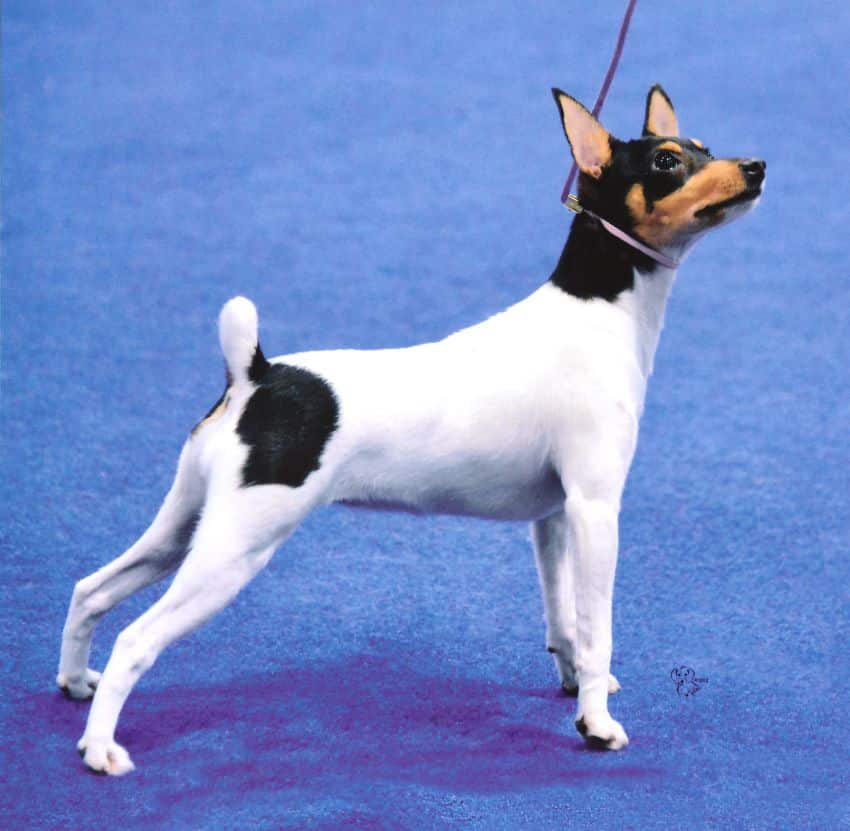
 The Toy Fox Terrier displays his Terrier-like, self-possessed and spirited attitude as he enters the show ring with both his head and tail carried erect. His smooth and flowing movement, coupled with good reach and strong drive, shows no hint of a bounce or hackney gait. A properly moving Toy Fox Terrier literally owns the ground he walks on. He is a well-balanced, athletic little dog with his grace and agility equaled to his strength and stamina. He’s all about Structure and Movement!
The Toy Fox Terrier displays his Terrier-like, self-possessed and spirited attitude as he enters the show ring with both his head and tail carried erect. His smooth and flowing movement, coupled with good reach and strong drive, shows no hint of a bounce or hackney gait. A properly moving Toy Fox Terrier literally owns the ground he walks on. He is a well-balanced, athletic little dog with his grace and agility equaled to his strength and stamina. He’s all about Structure and Movement! While the TFT is a natural “show-off” and enjoys strutting his stuff in the show ring, he does not necessarily like the table—and this should be understood by the judge. The first step in making this a positive experience for both the dog and the judge is to give the dogs some space. In an effort to avoid the dog being crowded and stepping back from the judge, the exhibitor can set the dog slightly further back on the table, leaving plenty of room for the judge to approach and conduct the examination. Many exhibitors train their show dogs to move into different positions by using a “crowding their space” maneuver, so it’s only natural to expect the dog to react if crowded. The next step is to keep in mind that the judge is checking for a scissors bite, which can easily be determined by examination of the front and both sides of the teeth, without even opening the mouth. There is no need to count teeth since missing teeth are not to be faulted. The TFT is examined on the table with gentle and confident hands, judged on the floor, and know that the happy little dog you see on the ground may not be so inclined to give you ears and tails up when he’s on the table.
While the TFT is a natural “show-off” and enjoys strutting his stuff in the show ring, he does not necessarily like the table—and this should be understood by the judge. The first step in making this a positive experience for both the dog and the judge is to give the dogs some space. In an effort to avoid the dog being crowded and stepping back from the judge, the exhibitor can set the dog slightly further back on the table, leaving plenty of room for the judge to approach and conduct the examination. Many exhibitors train their show dogs to move into different positions by using a “crowding their space” maneuver, so it’s only natural to expect the dog to react if crowded. The next step is to keep in mind that the judge is checking for a scissors bite, which can easily be determined by examination of the front and both sides of the teeth, without even opening the mouth. There is no need to count teeth since missing teeth are not to be faulted. The TFT is examined on the table with gentle and confident hands, judged on the floor, and know that the happy little dog you see on the ground may not be so inclined to give you ears and tails up when he’s on the table. The Toy Fox Terrier is not a cookie cutter breed, and this is not a bad thing as long as each style is within the breed standard. There can be significant stylistic differences from breeder to breeder, region to region, and coast to coast. One of the many wonderful things about these delightful little terriers is that there’s something for everyone! The diverse height standard of 8 ½ to 11 ½ inches at the withers allows breeders a choice as to how they would like their breeding program to develop, regarding size. It is also important for judges to understand that neither “short” nor “tall” is either right or wrong; it’s which exhibit best exemplifies the written AKC Breed Standard in all aspects of that standard—regardless of size.
The Toy Fox Terrier is not a cookie cutter breed, and this is not a bad thing as long as each style is within the breed standard. There can be significant stylistic differences from breeder to breeder, region to region, and coast to coast. One of the many wonderful things about these delightful little terriers is that there’s something for everyone! The diverse height standard of 8 ½ to 11 ½ inches at the withers allows breeders a choice as to how they would like their breeding program to develop, regarding size. It is also important for judges to understand that neither “short” nor “tall” is either right or wrong; it’s which exhibit best exemplifies the written AKC Breed Standard in all aspects of that standard—regardless of size.

